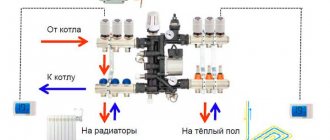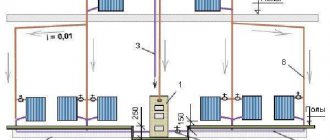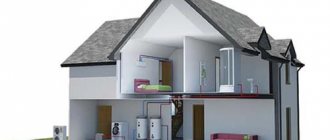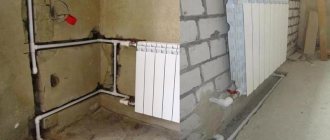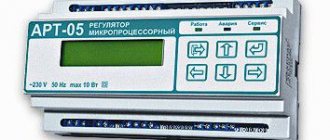The main function performed by the heating network is to maintain a comfortable temperature inside the premises it serves. Installation of heating systems is a complex and multi-stage task. Its successful solution should be based on professional design and knowledge of the intricacies of work production that are not noticeable at first glance.
What are heating systems
Heating networks include all engineering networks and communications designed to convert various types of energy carriers into thermal energy. In this case, both individual heating for individual residential buildings and centralized heating can be organized to serve neighborhoods and areas in large populated areas.
Each heating system must include:
- Heat source
- Design for transporting coolant
- Circulation and expansion devices
- Automation and Security Tools
Radiator installation
Radiators should be installed as responsibly as possible.
We have already completed the marking and installation of brackets for mounting the batteries. Now let's start assembling and installing them.
The first step is to unscrew the fittings (plugs) and prepare the radiator taps. It is better to use polypropylene taps, which are often included with the radiator.
Radiator tap made of polypropylene.
The threaded connection should be lubricated with Unipak paste and wrapped with tow. Some plumbers use FUM tape, but tow with paste is more reliable. We apply a generous layer to the thread and wind the fibers of flax tow along the thread.
Lubricate the threads with Unipak high-temperature paste and wind the tow.
Then we put on the union nut of the radiator valve and screw it on first with our hands, then until it stops with an adjustable wrench. We install another tap, then the Mayevsky valve, and close the last hole with a plug.
We screw in the taps, the Mayevsky valve and the plug.
Important! It is necessary to coordinate the positions of the taps with the connection diagram of the device: it can be bottom, side or diagonal.
If we have a Leningrad single-pipe system, we perform piping with a bypass. To do this, solder the pipe sections and connect them with a thinner pipe:
Radiator piping for a single-pipe system.
First, we install the adapters on polypropylene (if needed), then we install the adapter tee from D20 to D16 on one side, then the pipe, then the tee on the opposite side. The binding is ready.
We control the accuracy of the work with a level.
Finally, we install the device on the brackets and fix it. We check the levelness of the installation using a building level.
Types of heating systems
All heating systems can be classified according to a number of characteristics.
Fuel used
Depending on the type of energy carrier used, heat sources can be:
- Gas
- Solid fuel
- Liquid fuel
- Electric
- Geothermal
Installation of heating for cottages with boilers burning liquid fuel is extremely rare. Usually only in cases where all other fuel sources are unavailable and delivery is too expensive.
Electric heating equipment is easy to install and very convenient to use. But the cost of such heat is higher than when burning gas or solid fuel. Making changes to this situation, it is quite likely that the use of flat Tesla induction coils, which have recently begun to appear on the Russian market, can provide a solution.
Type of coolant
Depending on the type of coolant used, individual heating systems can be:
- Mermen
- Steam
- Electrical
- Gas
- Air
In our country, the most common heating schemes are those using liquid coolant. They are followed in approximately equal shares by electric and gas. Steam is used only in industrial enterprises, and the installation of air heating as the main one can only be found in the southern regions.
Type of circulation
The movement of heated water in heating systems can be organized in two ways:
- Naturally
- Forcibly
The main advantage of the first type is its complete independence from the stability of the power supply. In them, the coolant moves through the pipeline due to the ability of the liquid to rise upward when heated, and to fall down when cooled. But low stability of operation, the need to increase pipe diameters, the difficulty of adjusting the temperature and the use of radiators with a large internal volume make the use of such heating systems unpopular.
The forced movement of the coolant is carried out thanks to the operation of electrically driven circulation pumps. This allows you to significantly increase reliability, comfort of use and reduce operating costs.
Selection of heating pipes
Only a few types of pipes are used for heating systems, so there will not be any particular difficulties in choosing them:
- Steel pipes . This material has very high mechanical strength, so it is not afraid of various external damages. Another thing is that steel is susceptible to corrosion, so it can be damaged from the inside. Steel pipes accumulate heat well and partially influence the intensity of convection in the room. Installing heating in an apartment using steel pipes requires welding, so this work requires relevant experience or a good specialist.
- Metal-plastic pipes . One of the most inexpensive and easy-to-install pipe options for a heating system. The disadvantage is the large number of connections, which greatly increases the likelihood of circuit leaks. To reduce the likelihood of leaks to a minimum, you need competent heating wiring in the apartment and careful monitoring of it during operation.
- Plastic pipes . Another relatively inexpensive option that has a lot of positive qualities. Among the advantages are resistance to rotting and corrosion, as well as the highest reliability of the connections - they are processed using soldering, and if the work is done correctly, the seams will never leak. This material has no particular disadvantages, but you need to pay close attention to the characteristics of specific products when purchasing them.
When trying to decide which pipes to use for heating in an apartment, we can conclude that the best option, other things being equal, would be plastic pipes, which are excellent for self-installation. Radiators can be selected individually - they are connected in exactly the same way, and the whole difference lies in the individual compatibility of the heating system and the specific type of radiator.
Calculation of heating systems
Before starting the installation of the heating system, it is necessary to complete the calculation stage.
Calculation of heat losses
The main calculation required for this is thermal engineering. The result is the determination of heat losses in the rooms and the building as a whole. It is these heat losses that the heating system will have to restore and its power must be sufficient for this.
Thermal engineering calculations are carried out taking into account the five coldest winter days. These data can be found in SNiP “Climatology”.
We can say with confidence that only a qualified heating engineer with a special technical education can accurately calculate the heat losses of a building.
If we talk about small-sized cottages with standard architecture, then the installation of a heating system can be performed on the basis of a simplified calculation based on aggregated indicators.
With conventional glazing of a building without wide large stained glass windows, a room height of up to 3.2 m and normally insulated walls, approximately 1 kW of thermal energy will be required to provide heat to 10 m2. These aggregated data are slightly larger than the real ones that would be obtained as a result of thermal engineering calculations. The rooms served will definitely be warm. In addition, it is not at all difficult to reduce the amount of heat supplied if necessary.
The disadvantage of this approach is the unreasonable reserve of power of all equipment, which leads to an increase in the cost of heating systems. The boiler and radiators will cost about 10% more.
Based on the calculation of heat losses, equipment is selected:
- Boiler
- Radiators, convectors, heated floors
Hydraulic calculation
Its main goal is to determine the minimum permissible cross-section of pipes and reduce the cost of purchasing materials. The diameters of pipelines for the installation of heating systems are determined based on the results of hydraulic calculations. Also, on its basis, the selection of pumping equipment is made.
↑ Installation work
The first stage of installing a heating system is installing and piping the boiler. According to the regulations, powerful devices (from 60 kW) are installed only in specially designated rooms - boiler rooms. But, if the power is below 60 kW, the boiler can be placed in the kitchen.
According to regulations, boilers with solid and liquid fuels cannot be installed in rooms with poor air flow. Another prerequisite is the installation of a chimney.
The heat generator must be installed taking into account the permissible parameters of the distance to other equipment and walls in the room.
Any equipment has a passport and a manual, which indicates the available distances to the nearest objects in the house. If the manual does not contain this data, then installation must be carried out according to the following rules:
- The passage between the boiler and other objects must be at least 1 meter.
- The nearest equipment should be located 70 centimeters from the boiler.
- Two boilers should be located 1 meter apart. The distance between boilers, if they are located opposite each other, must be at least 2 meters.
Selection of materials
Before starting installation work, you must carefully consider the choice of equipment.
Pipes
Installation of heating systems is carried out using the following types of pipes:
- Cross-linked polyethylene (both for radiator networks and water heated floors)
- Metal-plastic
- Polypropylene reinforced with glass fiber or aluminum
- Cink Steel
- Copper
- Brass
- Stainless steel
Non-reinforced polypropylene pipes have a maximum heating temperature of 60˚C and therefore heating systems cannot be installed from them.
Black or galvanized steel pipes have excellent strength and are resistant to high temperatures from superheated water. However, they are susceptible to rust and are more difficult to install. The prices for these materials make it advisable to use them for piping furnace and boiler rooms.
Plastic pipes of small sections are durable, easy to install, but have limitations on operating temperature and pressure. Laying heating pipeline systems made of plastic is not practiced in areas where emergency operating conditions are possible. For example, at the outlet of hot water solid fuel boilers and drainage discharge lines in furnace boilers.
Copper, brass, and stainless steel pipes are rarely used due to the high cost of the material and the need to use special tools when performing installation work.
Today, installation of heating using pipes made of cross-linked polyethylene (for hidden installation) or pipes made of reinforced polypropylene (for open installation) is the most optimal option. For piping boiler equipment, it is advisable to use copper or reinforced polypropylene.
Heating devices
The choice of the type of heating radiators depends, first of all, on the efficiency of their heat transfer, the pressure of water heating systems, the coolant used, the requirements for their appearance, and cost.
Depending on the material of manufacture and design features, radiators are of the following types:
- Steel panel
- Steel tubular
- Bimetallic sectional
- Aluminum sectional
- Cast iron
In closed circuits, the flow of oxygen into the water is minimal and heating systems can be installed with any type of radiator. The limitation is imposed by the coolant used.
The best results in the mid-price segment are shown by steel panel radiators. When using bimetallic sectional radiators, you must remember that the coolant (if it is not water) can corrode the gaskets between the sections and the radiator will leak.
↑ Selection of coolant
For the coolant, desalted, pre-filtered water is most often used.
But this option is not suitable in cases where heating occurs periodically. Then the water can freeze in winter and break the system. In this case, the network is filled with “anti-freeze”. It is worth understanding that antifreeze, due to its specificity, can only be used in a system where there are no rubber gaskets. The liquid will soften them, which will lead to leakage. In addition, not all boilers can work with antifreeze. This parameter is always indicated in the equipment passport.
Heating water can be supplied directly. To do this you need to install a valve. Thus, it is convenient to add a certain amount of coolant when there is a shortage of it in the system due to gradual evaporation. “Anti-freeze” can be supplied using a pump. As for the open type of heating, filling it is even easier. Antifreeze can be poured directly into the tank.
Heating system installation
It is recommended to perform installation work in the following sequence.
Boiler room arrangement
It is recommended to begin installation of the heating system with work in the combustion room. Performed:
- Boiler installation
- Connecting chimneys
- Placement of additional equipment
- Wiring of all used boiler equipment
After this, connections are made to an external gas pipeline (if gas is used). The connection is carried out by a representative of the local gas service.
In this case, it is necessary to take into account:
- A pump to create coolant circulation is installed on the line returning it to the boiler. In this case, its working life increases significantly
- It is necessary to connect a hot water drain line to the return and supply circuits of heating systems to remove coolant in the event of repairs or accidents
- Each piece of equipment when installing heating systems must have a separate shut-off valve to enable its emergency shutdown
Placement of heating devices
Initially, the locations of radiators and convectors are marked. The possibility of using in-floor convectors should be ensured by the design of the floor, in which special niches are made for them.
Side plugs are installed on the radiators, all connecting fittings and end fittings are screwed in for connection to the pipeline.
Radiators are installed in such a way that the distance to the finished floor mark should not be less than 150 mm, and to the window sill 100 mm.
Installation of heating pipeline systems
There are several pipeline laying schemes. In modern houses, you can increasingly see radial (collector) piping, in which each radiator or convector has its own connection to the distribution manifold.
Heating installation can be carried out using a two-pipe wiring diagram. Its main disadvantage is the large number of pipe joints, which reduces reliability. That is why it is optimal to install two-pipe wiring in an open design.
The laying of pipelines is carried out according to a pre-developed scheme or on the basis of a project.
Installation of a heating system made of polyethylene pipes is carried out using tension press fittings, crimp or tension rings. PVC pipes are assembled more easily by soldering using a special welding machine. All threaded fittings are connected in the traditional way by packing on ordinary brushed flax (tow) and sanitary silicone.
Connecting heating devices
At this stage, pipelines are connected to radiators, convectors, and heated floors. All connections are made with standard fittings.
Connection to radiators can be bottom, side or diagonal. From the point of view of aesthetics, the bottom connection is optimal, from the point of view of the efficiency of heating systems - diagonal. Which connection to choose is determined individually in each case.
Hydraulic tests
At the final stage, hydraulic tests are carried out. The installed circuits are filled with water and left under pressure. The pressure should not drop during the entire hydraulic test. If this happens, the location of the leak is sought and its cause is eliminated. After this, the tests are repeated until the pressure is constant.
↑ Errors during installation
When installing a heating network yourself, you can make many mistakes. That is why many recommend, if not completely entrusting the installation to specialists, then at least get a consultation. Let's look at five mistakes that installers consider the main ones:
- The choice of coolant was made incorrectly.
- Mistakes were made when wiring the heat generator.
- The heating network was selected incorrectly.
- Illiterate installation of fittings and pipes.
- Incorrect installation and connection of heating devices and automation equipment.
If a boiler has been selected with a power that is not enough to heat the room, then it is extremely difficult to eliminate such an error.
Often the boiler is also used to heat water for domestic hot water needs. Then there is not enough heat to heat the rooms. The heat generator does not function 100%, and the coolant in the radiators does not heat the liquid to the required temperature.
The boiler piping must not only perform its functions, but also be safe. For example, on the return line the pump must be installed in front of the heat generator. The pump shaft must also be positioned horizontally.
The expansion tank is used with a volume of 10% of all water in the network. When using an open circuit, it is installed at the very top; if the circuit is closed, then it is mounted in front of the pump. Between them there is a mud pan installed horizontally with the plug towards the bottom.
But if the heating network was chosen incorrectly, you will end up overspending on materials and installation. Often then you have to reinstall the heating system, and this is an extra expense.
This error most often occurs when installing a single-pipe network, when 4-5 batteries are connected to one branch. As a result, they are not heated.
Installation errors include failure to comply with slopes, poor fastening and installation of the wrong reinforcement.
Let's consider the disadvantages of autonomous heating of private houses:
- You will need to buy equipment, components, and building materials.
- If you do not buy automatic control, you will need to monitor the work process.
- If the boiler was purchased with liquid or solid fuel, you will have to fill the hopper.
- There is a danger that a fistula will appear and the coolant will leak.
True, the advantages of autonomous heating are more than enough:
- Versatility. You can select boilers according to the type of energy carrier or form a combined network.
- The building materials market is represented by a large selection of components. You can buy the necessary elements at different prices.
- Easy to customize. The circuit allows you to regulate the temperature.
- The indoor air is not too dry.
- If a separate circuit is installed, connected to the boiler, then hot water can be supplied.
- The use of automatic sensors makes it possible to control the process via the Internet, Wi-Fi or GPS.
Important! Before purchasing, calculate the boiler power. The power required is 5-10% higher than theoretically calculated. Devices that do not wear out will last much longer.
Recommendations and tips
In conclusion, I would like to give a few recommendations that may be useful.
- Installation of piping systems should be carried out taking into account the fact that tension fittings cannot be laid in the floor and walls. If this occurs, a small amount of free space must be left to accommodate the connections.
- Radiators should be within 70% of the window width. Panel radiators can ensure that this condition is met. Changing the thickness of the device allows you to change its overall dimensions, and choosing the best option is not difficult
- Installation of smoke removal systems should not pass through rooms with long-term occupancy. With an external chimney, it should be taken into account that the distance from it to the windows of residential premises must be at least 800 mm
- When using non-freezing antifreeze liquids as a coolant, sectional radiators cannot be installed. After a certain time, nipple connections may leak
- Using a room thermostat with an on-timer allows you to save up to 40% of the energy spent on heating
There are still a huge number of subtleties and nuances. If you do not have experience, knowledge, or working skills, then it is better to entrust the installation of heating systems to a trusted Contractor. The usual cost of work is estimated at 30-40% of the price of equipment and materials.
The best option is to conclude an Agreement with a company that will carry out all the work on a turnkey basis - develop a scheme or carry out a project, complete the equipment and install it. Practice shows that the installation of turnkey heating systems helps the Customer save significantly. It is necessary to pay attention to the fact that all materials and work are provided with a Guarantee.
Read other articles on this topic
| Autonomous heating of a private house | Heating a private house with forced circulation |
| Heating a private house with convectors | Heating options for a frame house |
| Heating system for a private house with natural circulation | Heating your home is the most economical way |
| Heating a private house with underfloor heating | Heating wiring diagrams from a boiler in a private house |
| How to heat your home without gas | Collector heating system for a private house |
| Heating distribution for a two-story house | How to save on heating a country house |
| Heating and water supply of a country house: description of installation technology | Heating a private house with electricity |
| Heating a private house from metal-plastic pipes | Heating project for a private house |
| Installation of a heating system in a private house | Combined heating system for a private house |
| The best heating for a private home | Heating a private house with a heat pump - pros and cons |
| Water heating in a private house | How to heat a private house |
| Infrared heating of houses | Heating the house with liquefied gas |
| About heating schemes for a private house with a gas boiler | Heating diagram for a two-story house |
| Heating system for a private house using a warm baseboard | Basic rules for the location of radiators when heating a private house |
| Do-it-yourself heating of a private house made of polypropylene | Features of heating a country house with electricity |
| Gas consumption for heating a private house - consumption calculation | Country house heating system |
Services on this topic
| Heating design | Turnkey solid fuel heating |
| Turnkey gas heating | Turnkey heating |
| Heating in a turnkey wooden house | Turnkey water heated floor |
| Installation of water heated floor | Heating a two-story house |
| Heating installation in a cottage | Heating a country house: options and prices |
| Heating installation | Heating installation in a private house |
| Installation of plumbing and heating engineering systems | Diesel heating of a country house |
| Autonomous heating on a turnkey basis | Air heating of a country house |
| Prices for heating installation in a private house | Design and installation of heating systems |
| Water heating in a private house | Electric heating of a country house: options and prices |
| Heating in a townhouse | Gas heating design |
| Heating design cost | Heating calculator for a private house |
| Installation of water heated floors in a private house | Price for installing a water heated floor |
| Installation of water heated floors on a wooden floor |
Water heating, what you need to know and what you need to install it
It comes with natural and forced circulation. It is also worth noting that the system can be open or closed. And the coolant most often used is water or, for example, antifreeze. Typically the heating system is a closed type using water.
Closed water heating system
Water heating, natural circulation
As already noted, the advantage of such heating will be complete autonomy. It is enough to have a source of water supply and an available type of fuel for the operation of such heating. True, installation of a heating system of this type requires mandatory compliance with certain requirements:
- the boiler must be placed at the lowest point of the coolant circulation circuit;
- heating pipes must be of large cross-section;
- The installation of the heating system must be carried out with a slope, i.e. the pipes must have a slope towards the radiators and heating boiler so that the coolant flows by gravity;
- limited area (up to one hundred and fifty sq. m.) that can be heated using a similar method.
Heating scheme with natural circulation
Water heating, forced circulation
In this case, the heating system installation diagram includes a circulation pump. Thanks to it, there is no need to adhere to the requirements described above; the entire system becomes more universal and can work in any conditions.
Water heating with forced circulation
The advantage of this type of heating is that it has no restrictions on the size of the heated area. In addition, the heating efficiency of such a heating system is much higher.
What is needed for heating installation?
In order to create autonomous heating, you need:
- Heating boiler. They can be designed for different types of fuel (gas, liquid or solid) and for different power. The required power must be determined in accordance with the size of the heated area and possible heat losses. When choosing a boiler, you need to take into account the use of hot water for household needs. To have this opportunity, you need to choose a double-circuit boiler.
- Heating radiators. By and large, the type of radiator (aluminum, cast iron or other material) does not matter. It is best when they have the ability to install additional sections and are designed to connect to the pipe diameter of your choice.
Metal heating radiators
- Pipes. Today, the choice of possible types is quite extensive. These can be steel (outdated, requiring constant maintenance and replacement), plastic, copper, etc. The most commonly used are metal-plastic ones, which are inexpensive and do not require special skills during their installation.
- Taps, fittings, manifold distributors, filters. Elements that allow you to connect individual parts into a single system, ensuring its normal functioning and the ability to make the necessary adjustments.
- Expansion tank. When heated, water expands and it is needed to compensate for this expansion and prevent pipe rupture.
- Circulation pump. Heating boilers of some models have a built-in pump, but if it is not there, you will have to install it additionally.
Circulation pump
Hot water supply (DHW)
There are a large number of ways to obtain hot water. You can use a storage water heater that operates independently of the boiler responsible for heating, or a flow-through one. The heater can be gas or electric, and combined options with solid fuel can also be used. If the boiler, in addition to heating, is also responsible for hot water supply, then it is called a double-circuit boiler. Such a boiler may have a built-in boiler or be a flow-through type.
If hot water is required in not very large quantities (about 15 liters per minute when heated to 30 degrees), then it is better to use a double-circuit flow-type boiler. A better quality hot water supply is obtained by installing a boiler with a built-in boiler. Depending on the model, it constantly provides from 45 to 60 liters of hot water, ready for use. The boiler also makes it possible to store hot water for a certain period of time when the gas is turned off. But in addition to increased comfort, boilers with a built-in boiler also have some disadvantages. So they have quite a large weight and dimensions, and they also have increased gas consumption so that the water is constantly maintained in a heated state.
If the house has several water intake points (for example, a shower, a jacuzzi, a bathroom), which operate simultaneously and consume a large amount of water, then a large-volume boiler (for example, 200 liters) can be connected to the boiler (both single-circuit and double-circuit). This usually completely satisfies the hot water needs of even the most demanding users.
Heating appliances.
Heating devices must be selected according to thermal power, which is calculated using the same formula: approximately 1 kW of energy is consumed per 10 square meters of room . Also for city apartments, the pressure for which the heating device is designed is important. It is also worth considering that the device will always be present in the interior of the apartment, so it is important to pay attention to its design.
Types of heating devices.
Traditional radiators have a fairly large volume, due to which they contain a lot of coolant and are very inertial. Heat from them, as a rule, comes in the form of radiation.
Convectors - give off heat due to air circulation. Inside the convector has a pipe through which the coolant passes and heats the surface of the accordion, which has branches. The air moves through the convector from bottom to top and heats up as it passes through a large number of warm fins.
Panel radiators are combined heating devices that combine the qualities of convectors and radiators.
Selecting a heating boiler.
In order to choose the right boiler you need:
- Decide on the optimal type of fuel for a given area. You can choose from several options - diesel fuel, solid fuel (coke, wood, coal), electricity, gas.
- Choose a boiler with suitable power in order to heat the entire volume of the room with minimal coolant costs. For a building with good thermal insulation and three-meter ceilings, the approximate boiler power will be determined by the ratio of 1 kW of boiler power to 10 square meters of area. For the final calculation of the required power, it is worth contacting specialists.
- Decide whether the house needs hot water supply or only heating is required. If you also need hot water, you will need a boiler with a boiler (single-circuit) or a double-circuit boiler.
Radiator installation
At the last stage, radiators are installed. The highest quality ones are steel and aluminum. You need to choose the size and heat output in accordance with the size of the room. Do not forget about the thermal conductivity of the wall material, as well as the number of doors and windows.
If you want to additionally install a “warm floor” system, then you need to lay two pipes. To support the pipes, fasteners are installed every 2 meters - if it is made of metal and every 1 m - if it is made of plastic. It is better to lay such pipes above the floor. After installing them, hang the radiators and install the floor heating system.
If the walls are made of stone, then using dowels, hooks are mounted on which the batteries are hung. The hooks are then cemented. If the walls are wooden, then a self-tapping screw is enough. In order to reflect heat into the room, you can lay a polyethylene foam screen between the radiator and the wall.
After carefully studying the article, you can install the heating system yourself. Thus, saving your money and making heating as comfortable as possible for your home.
